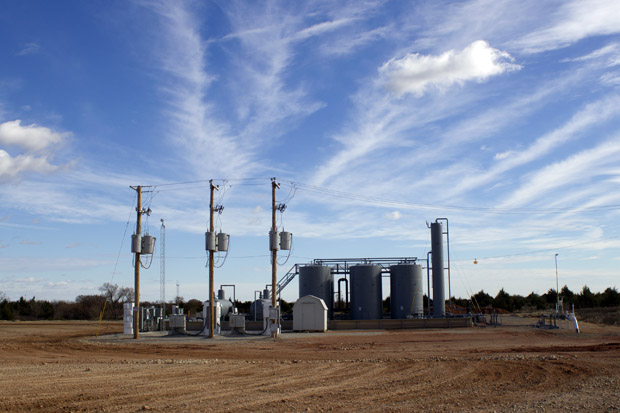
A Devon Energy disposal well near Stillwater, Okla.


A Devon Energy disposal well near Stillwater, Okla.

A Devon Energy disposal well near Stillwater, Okla.
The Oklahoma Corporation Commission in March ordered the operators of nearly 350 disposal wells to prove their operations weren’t allowing waste fluid to be pumped into a rock formation known to produce earthquakes.
The Corporation Commission has not provided comprehensive records or data related to the operators’ responses to the March directives despite multiple requests by StateImpact. Today, the commission issued a statement that provides a snapshot of the industry’s response to the directives:
- More than 50 disposal wells have had to shut down operations and reduce total depth to provide disposal into only the Arbuckle formation to mitigate the potential risk.
- Approximately 150 other disposal wells have reduced their volumes by 50 percent.
- Other wells are keeping volumes below 1,000 barrels a day.
The March 18 orders, known as directives, were sent to 92 operators of disposal wells in quake-prone areas, and represent the state’s most aggressive quake-related regulatory response to date.
People or companies who received the directives were ordered to prove their wells weren’t in contact with crystalline granite “basement rock” by supplying the commission with well logs or records of gamma ray tests.
Under the March orders, operators of wells in contact with basement rock were required to fill in the well to a shallower depth — a process known as a “plug-back” — or reduce their disposal volumes to 50 percent of their annual permitted amount. All disposal well operators are allowed at least 1,000 barrels a day.
Tim Baker, the director of the commission’s Oil and Gas Division, praised the industry’s response to the March directives, but said the commission’s tougher disposal well permit process is still evolving and “more remains to be done.”
“While our primary concern is the high-volume […] wastewater disposal wells because they pose the greatest potential risk, the lower-volume Arbuckle wells are also subject to the same directives and must be addressed,” Baker said in the statement. “It’s also important to understand that these actions are based on quickly addressing the areas of highest potential risk as defined by the research. We continue to work with the Oklahoma Geological Survey and other researchers on this critical issue and our ‘traffic light’ system. All options available to us to address this are on the table. There is no issue more important to us.”
The commission’s full press release is below: